Microsoft Surface Review
by Anand Lal Shimpi on October 23, 2012 9:01 PM EST- Posted in
- Tablets
- Microsoft
- Mobile
- Surface
- Windows RT
Display: Not Retina, But Still Good
Surface features a 10.6 inch, 1366 x 768 16:9 display. The physical size is a bit unusual, although the display resolution is something we’ve seen used in affordable notebooks for years now. We already know why Microsoft picked the display size (to enable better multitasking and make for a good keyboard size), but is there room for a flagship tablet with only a 1366 x 768 display resolution?
Microsoft’s response to the resolution question is that more pixels isn’t necessarily better, and that there are a number of other factors that are just as important. It also is quick to point out that a significantly higher resolution display would have increased memory bandwidth requirements, decreased UI frame rate and required a larger battery. As NVIDIA’s Tegra 3 only has a single channel LPDDR2 memory interface, driving a 2048 x 1536 panel and maintaining Microsoft’s UI performance requirements was out of the question. Apple ran into the same issue and ended up building the A5X SoC with an insanely wide memory interface to deal with it. Down the road I’d expect the memory bandwidth problem to get solved, but that still leaves a power consumption issue. Apple moved to a 42.5Wh battery in the 3rd generation iPad, a 37% capacity increase compared to the 31Wh unit in Surface. Enabling a similar panel would have pushed size and weight of Surface more than Microsoft would have liked.
Given those constraints Microsoft chose a different route with Surface. Rather than focus on pixel density it focused on improving contrast and reducing glare. Surface laminates the cover glass and LCD panel together, removing an annoying air gap that’s responsible for some reflections/glare and a reduction in brightness. Apple’s recently announced 8th generation iMac does something similar, as do a lot of high end smartphones, but Surface is among the first to do so with a ~10-inch LCD. The effect is noticeable in a contrived photo but it also results in a display that’s not half bad to look at.
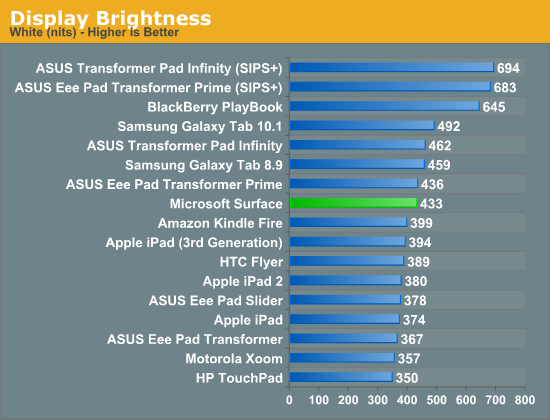
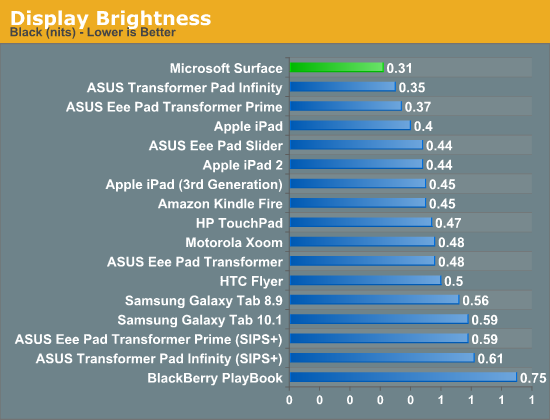
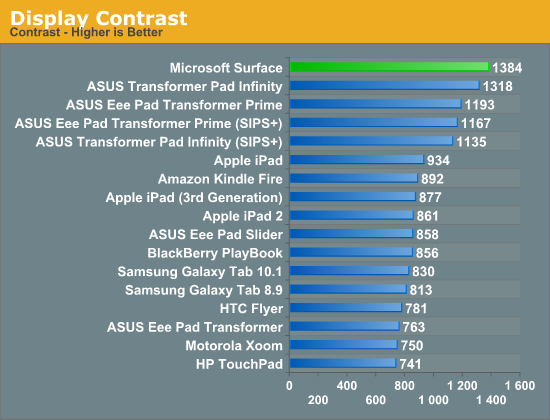
With the exception of text on web pages, the lower resolution Surface display isn’t overly bothersome. I would like something a bit higher resolution although I don’t know that matching Apple’s pixel density is absolutely necessary if Microsoft can deliver elsewhere.
Apple doesn’t just rely on resolution to sell the iPad’s Retina Display, it also happens to do quite well at accurately representing colors. I put Surface through AnandTech Senior Display Editor, Chris Heinonen’s excellent tablet/smartphone analysis workflow to see how well it did:
| CalMAN Display Comparison | ||||||
| Apple iPad (3rd gen) | Apple iPad 2 | ASUS Transformer Pad Infinity | Microsoft Surface | |||
| Grayscale 200 nits Avg dE2000 | 3.7333 | 1.3826 | 3.9881 | 3.6769 | ||
| CCT Avg (K) | 6857K | 6632K | 6632K | 6407K | ||
| Saturation Sweep Avg dE2000 | 3.193 | 6.8404 | 6.8404 | 7.3617 | ||
| GMB Colorchecker Avg dE2000 | 3.0698 | 3.8957 | 4.4177 | 5.3057 | ||
Saturation

Gamut
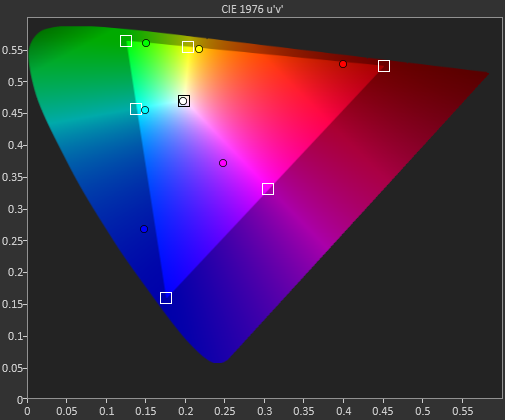
GMB Color Checker
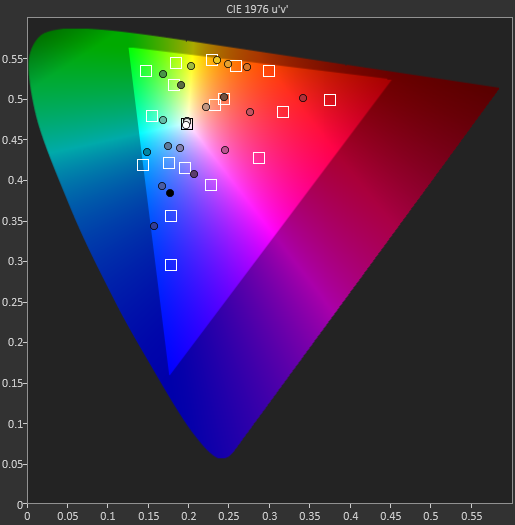
Grayscale accuracy is slightly better on Surface compared to the iPad, however the rest of the accuracy metrics show Apple’s tablet ahead of Surface.
This isn’t to say that Surface’s display is bad, in fact I think it’s quite good and I’d argue that it was never a problem in my testing, but it’s definitely not the best on the market today. I’m also not sure how much of this has to do with Microsoft’s panel selection vs. software calibration. None of my calibration tools work under Windows RT so I couldn’t really tell you.
I did reach out to Microsoft and they did say that some of my values in the charts below looked a little off. I’ll be rerunning data on another Surface sample as soon as I get a chance to.










235 Comments
View All Comments
walkman - Friday, October 26, 2012 - link
Did anyone else go back and check the byline for this article? I highly respect Anandtech reviews but this one was written with a glibness and giddiness that seems very uncharacteristic. If it wasn't Anand I would write it off as a MS PR hack, but it is so I'm trying to keep an open mind. Anand review are usually very late so it's also surprising to see this detailed review so quickly. He likes RT so much he makes sound like he will like better than Win 8. Perhaps he has a bias for MS (I do) so he's just excited to see MS get back in the game vs competitors.twotwotwo - Saturday, October 27, 2012 - link
The Atom/ARM head-to-head is awesome. Noteworthy that the Exynos 5 Dual in the Chromebook got a 711ms SunSpider score (in another site's test) compared to the 714ms for Atom here, and x86 usually smashed on SunSpider in the past because of its wider memory interface. (Of course, I'm implicitly comparing Google's JavaScript VM against Microsoft's too, not just the chips. And someone actually buying a Windows tablet might go Atom just to get Windows 8 and legacy app compatibility instead of RT.)Bet I'll hear more about the ARM-meets-Atom thing in your Chromebook review. For me as a user, seems like the big deal is that mobile architecture wars are on like Donkey Kong; only good news for me.
MrSpadge - Saturday, October 27, 2012 - link
Wow.. imagine we could get this pixel density, IPS and almost 1:1400 static contrast on any regular laptop display! It may not beat the iPad3 display.. but in absolute terms and especially compared to what we usually get any 500€ or 2000€ machine this is just gorgeous!I also can't understand people wanting an even higher resolution stating "but Apple's got the higher dpis". Personally I find 1366 x 768 to be very crisp and borderline too small at 11.6", so there'd be no benefit of going smaller but drawbacks (scaling, power consumption, cost). I don't think the trade-off would have been worth it.
johnsmith9875 - Tuesday, October 30, 2012 - link
But does Surface run in Portrait mode? Does the hardware have the position sensors and does the software check for those? I've seen it only being demonstrated in landscape mode.crispbp04 - Monday, November 5, 2012 - link
Yes, it is beautiful in portrait and landscapebhima - Tuesday, October 30, 2012 - link
Haswell + Win8 x86 will be epic. I don't care about RT. In fact, it feels like Microsoft is hedging its bets with RT vs its x86 Surface tablets. Here's hoping x86 stays around so you can actually use software you already own, have real application choices and have a truly seemless integration between tablet, notebook and desktop... not just some fancy looking sync software.Silma - Monday, November 5, 2012 - link
Congratulations on the most informative review of the Surface I read to date.Surface seems exciting although a sub FullHD screen and only 2GB of RAM are a big turnoff.
I am looking forward to reading your review of the Surface Pro when it becomes available.
ezrasam - Thursday, November 8, 2012 - link
Revolution of the decade.ijabit - Tuesday, November 20, 2012 - link
I can confirm that I had the exact same problem outputting video to my 42" plasma. The poor quality was very noticable and one of the main reasons I returned it (we watch a lot of netflix streaming from a PC). I never had a problem with my (super slow) Asus laptop and HDMI out.bogieworf - Wednesday, November 28, 2012 - link
I personally used the new Nook HD + before returning it and replacing it with the Surface. My wife owns the iPAD 3. Here are my thoughts about the devices.If the Nook HD+ (9" model) isn't the perfect e-Reader, it is close to it. Anything larger would require two hands. The case that BN offers for the Nook allows standing the Nook either upright or sideways, and the software is great for reading. Unfortunately, BN's tech support leaves much to be desired and I was forced to return the device because they could not find out why one of my daily newspapers was not being automatically downloaded each day. Sad, really, because I REALLY like the device. But make no mistake, this is an e-Reader first and secondarily everything else.
Going from the Nook to the Surface, the Surface is much more expensive and much more versatile. Windows R/T is a pretty slick piece of SW. Love the Tiles being able to re-arrange them and the updates that appear in the Tiles. Is the Surface as good a reader? No, its too big as you need two hands to hold the device. Is it an more than adequate reader? Yes.
The Surface is a tablet designed primarily for media consumption and secondarily for productivity. It is currently THE tablet to own if you value productivity. Word, Excel and Power Point come pre-loaded. The keyboard that doubles as a cover is a great design as is the built in kick stand. This device has the advantages of the much touted Yoga in a much smaller, thinner and lighter package. The iPAD simply does not compare as a productivity device and the Tiles with auto updating makes iOS seem dated. Is the iPAD the better media consumption device? Yes. The display and apps place the iPAD well in front of the Surface, but the more you value productivity, the more the Surface makes sense.
But understand, the Surface offers a light version of productivity for most people. If productivity is your first concern, something the size of a convertible (12.5" or more) would be much better. The Yoga, for example, would be a good productivity device while still being thin and light enough to secondarily offer decent media consumption and portability. But the Yoga is not a device you are likely to pull out during your daily commute, at least not on the subway. It is too big and cumbersome for that, the Surface is not.
Taken for what it is and what it offers, the Surface is a great device for the right person. You need to appreciate the Surface for what it is and what it was designed to do, not for failing to be something it was never intended to be. If nothing else, MS should be credited for re-thinking the tablet space and not producing another iPAD wannabe. This is a very well thought out and executed product..